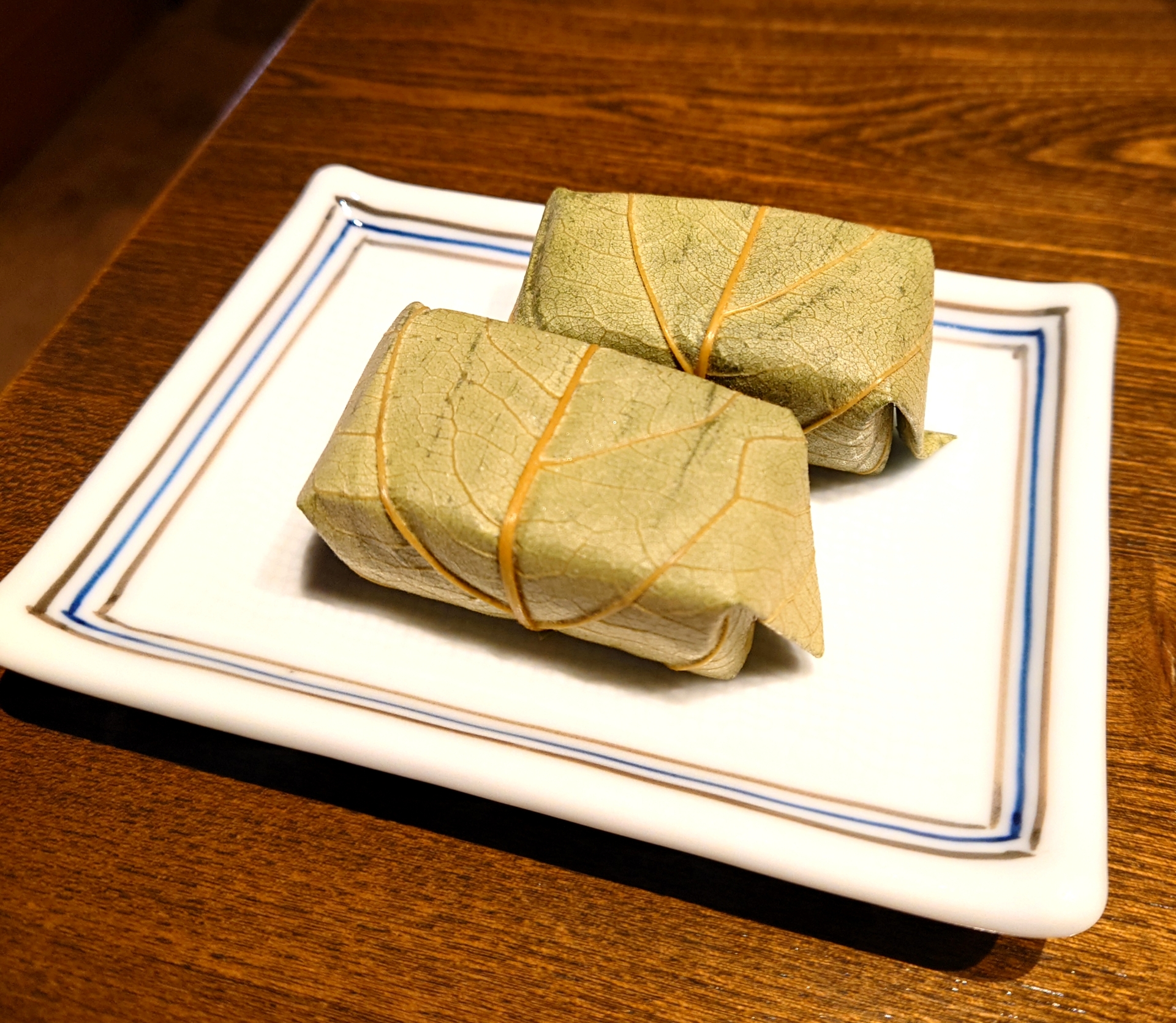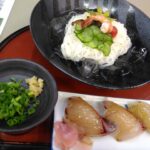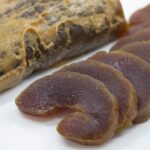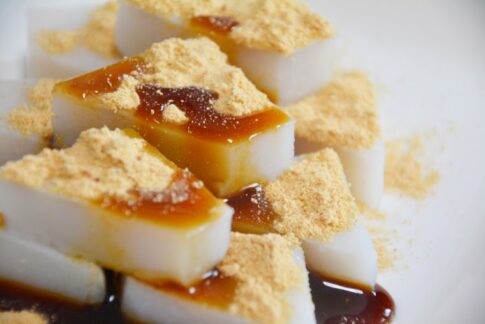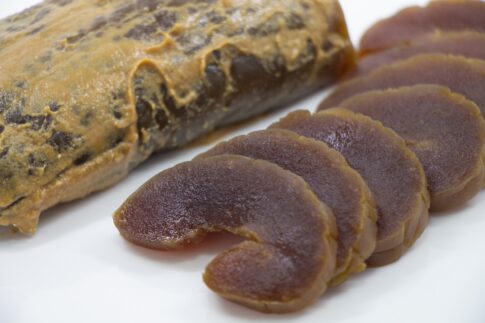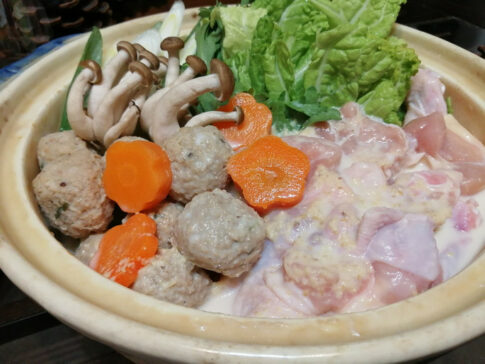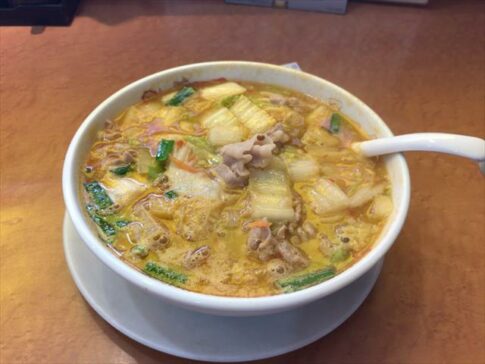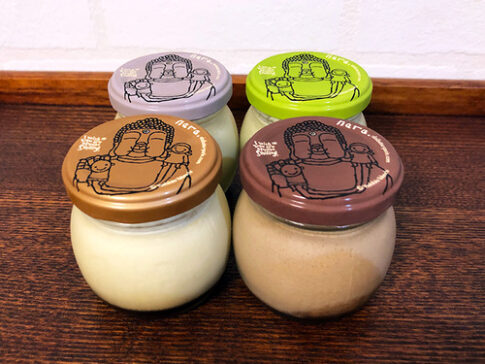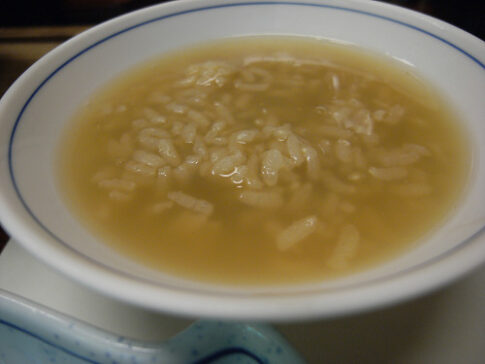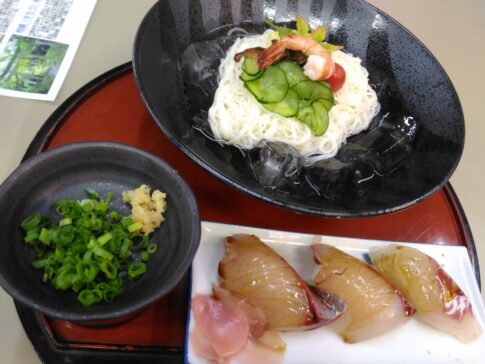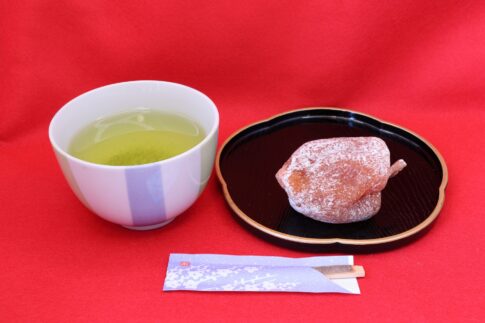Have you ever tried Kakinoha Sushi?
You can find it at any places in Nara like souvenir shops, restaurants on the street and stores inside the stations.
People in Nara Prefecture love this food. If you want to try, it is easy to get!
Nara Travelers Want to Know About Kakinoha Sushi (Persimmon leaf sushi)

1. What Kakinoha Sushi is
Kakinoha Sushi (or Kaki no Hashi-Sushi) is a local dish of Nara and Wakayama Prefectures, as well as the Kaga region of Ishikawa Prefecture and the Chizu region of Tottori Prefecture.
The method of making and shape differs between Nara and Wakayama prefectures and Ishikawa and Tottori prefectures.
Mackerel and salmon are the main ingredients (neta) used in both regions, but sea bream, conger eel, and shiitake mushrooms are used in Nara and Wakayama Prefectures, yellowtail in Ishikawa Prefecture, and trout in Tottori Prefecture as a region-specific ingredient.
2. What Kakinoha Sushi is like in Nara Prefecture
Nara and Wakayama Prefectures
Sushi is made by combining a bite-sized piece of vinegared rice with mackerel or salmon fillets, wrapped in a persimmon leaf, and pressed. In some places, kombu (kelp) is wrapped around the sushi before wrapping it in kakinoha (persimmon leaf).
In many places, the name “Kakinoha Sushi” is used. Kakinoha Sushi is eaten with the persimmon leaves removed.
3. History of Kakinoha Sushi
Kakinoha sushi is said to have originated in the Edo period (1603-1867) in the upper reaches of the Kino River.
According to one theory, fishermen from the Kishu Clan used to pack the bellies of mackerel caught in nearby waters with salt and then peddle them to Yamato using the Kino River and Kumano River for transportation.
This is said to be the origin of kakinoha Sushi. At first, it was eaten like nare-zushi, but after the spread of brewed vinegar in the mid-Edo period (mid-Edo period), the style of sushi using vinegared rice as we see today is said to have been adopted.
Since then, it has been highly prized as an indispensable treat for festivals and celebrations, especially in the Gojo, Yoshino, and Omine regions.
The technique of wrapping food in persimmon leaves has been handed down throughout the region as a traditional preservation technique, and it is said that persimmon leaves have a sterilizing effect.
Furthermore, by wrapping the sushi in persimmon leaves, the aroma of the leaves is transferred to the sushi, enhancing its flavor.
Persimmon leaves are sometimes pickled in salt to soften them or to increase their sterilizing effect.
Shibu (astringent) persimmons (especially Tone early ripening are considered the best) are better suited for this purpose because of their softer leaves.
In the old days, only mackerel was used as the main ingredient, but in the Meiji era (1868-1912), “Heimune” proposed Kakinoha Sushi with salmon, and today, mackerel and salmon are the standard ingredients.
Today, mackerel and salmon are the standard ingredients, and an increasing number of restaurants offer a wide variety of Kakinoha Sushi, including sea bream, anago (conger eel), octopus, sayori (Japanese halfbeak), shrimp, shiitake mushrooms, and daikon (radish).
Tanizaki Junichiro is credited as one of the people who popularized kakinoha sushi. In his essay “In-ei Raisan,” Tanizaki wrote of Kakinoha Sushi, praising it as “a taste exceptional to the nigirizushi of Tokyo” and “in some ways, a luxury beyond our imagination.
4. Where to Buy Kakinoha Sushi
Kakinoha Sushi is a specialty of the Ito region of Nara and Wakayama prefectures, and is sold at major stations on the JR and Kintetsu lines (mainly at limited express stops on the Kintetsu line).
It was also sold in Kintetsu limited express trains. In Nara Prefecture, persimmon leaves grown in the Gojo and Yoshino areas are widely used.
It has been selected as one of “Nara’s Good Foods” and is widely accepted as a souvenir, gift, or for home use, with kaki no ha sushi stores being found all over the prefecture.
In addition, there are many private stores and restaurants serving Kakinoha Sushi scattered throughout Yoshino Town, Sakurai City, Shimoichi Town, and Kawakami Village.
In Kawakami Village, Kakinoha Sushi, which is made from old-fashioned salted mackerel without vinegar, is the most common style, similar to the early style.
It is also designated as an excellent souvenir recommended by Wakayama Prefecture and several stores can be found in Kihoku, especially in Ito-gun.
5. Why Kakinoha Sushi was made
Persimmon leaves are rich in tannin, a type of polyphenol, which is believed to have antibacterial and antioxidant properties.
It is said that wrapping sushi in persimmon leaves not only prevents it from drying out, but also improves its preservation.
The origin of Kakinoha Sushi is not known for certain, as there are no exact documents or other information available.
It is believed to have been popular at least in the mid-Edo period in Gojo and the Yoshino River basin, where persimmons were grown.
Although this area is very mountainous and has no sea, fish such as mackerel caught in the Kumano-nada Sea in Kishu were brought to this area by peddlers. Since it takes about two days to reach Yoshino by horseback, the fish were pickled in salt for preservation as soon as they were landed.
The fish was originally quite salty, and the salt soaked into it during transportation, making it too salty to eat as it was.
In order to enjoy this precious seafood, they came up with the idea of shaving each piece of mackerel into thin strips and serving them with bite-sized pieces of rice.
Eventually, they began to wrap it in persimmon leaves, which were abundant in the area, to prevent it from drying out.
This was then weighed down to remove excess air and left to ferment for about three days to enhance its shelf life. It was so well preserved that it could be eaten for three days after completion.
6. How to Eat Well at Home
Kakinoha sushi is delicious eaten as is, but during the cold season, the rice can feel tough.
In such cases, we recommend baking Kakinoha sushi. Baking the whole leaf in a toaster oven for 5 to 6 minutes is said to make the rice fluffy.
The fat from the fish and the aroma of the persimmon leaves will blend with the rice, giving it a different taste. Please give it a try!
Summary
Kakimoha Sushi has a unique smell and taste like Narazuke that we mentioned in previous blog.
But it is worth trying one of the oldest Japasene sushi!
